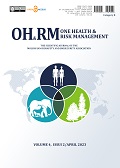Abstract
Introduction. Injury is a significant public health concern that is a leading cause of mortality and disability worldwide. Injuries have a significant financial and quality-of-life impact on persons and communities. The absence of fundamental epidemiological data on the prevalence of injuries prevents developing countries from creating effective prevention programs. The goal of this study was to characterise the epidemiological features of injury in the Adjara region. Material and methods. The database and source of the data that we used in this article were provided from the Georgian National Center for Disease Control and Public Health’s 2019 database, which contains all hospitalizations in the Adjara area and was utilized to find trauma cases that were treated at medical facilities. Based on the ICD-10 diagnosis codes S and T, as well as V-Y, cases were chosen. Version 23.0 of SPSS was used to analyze the data. Results. Between the ages of 0 and 103, there were a total number of 2,239 patients, inclusive 1,321 (59%) – males, and 918 (41%) – women, who were hospitalized for treatment of an injury. The incidence was highest among those aged 65 and over (n=510; 23%), followed by those aged 20-34 (n= 488; 20%). The most prevalent cause of injury was falling (n=1,324; 59%), followed by exposure to inanimate mechanical forces (n=244; 11%). The range of hospital stays was from 1 to 3,652 days, with a median and mode of 3 and 2 days. Conclusions. This study provides information for public health decision-making. In order to enhance the standard of treatment and focus efforts on avoiding more injuries, intervention strategies may be devised using our data to understand better the extent of the injuries and outcomes linked to traumatic injury hospitalizations.
|
 Views: 393|
|
Views: 393|
|
This work is licensed under a Creative Commons Attribution 4.0 International License.

